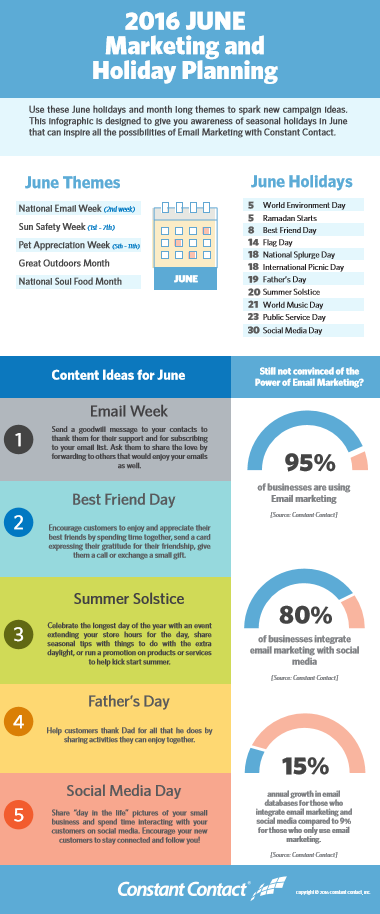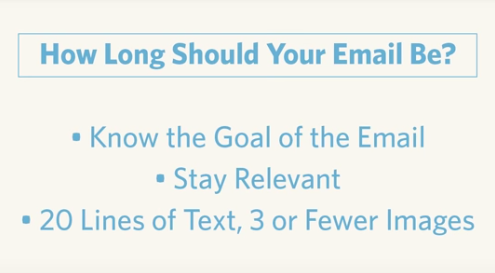Your July marketing & holiday planner is here!


Use this list of holidays, month-long themes, and stats to inspire new email and social media marketing campaign ideas for June. Enjoy!

![]() To get your email opened and read, you understand the importance of sending it at the right time. You understand the importance of a compelling subject line. You understand the importance of segmentation: sending the proper message to the proper group.
To get your email opened and read, you understand the importance of sending it at the right time. You understand the importance of a compelling subject line. You understand the importance of segmentation: sending the proper message to the proper group.
So now you’ve got them interested in your email, but what are you going to talk about? Many marketers get stuck here. Deciding what to write can be a little less confusing by following these concepts.
Here’s a list of ideas to get you started today!
At the end of the day, it’s so important to remember that content marketing really isn’t about what you want to say, but about what your audience wants to hear. You know your tribe, so speak their language! Marketers who can remember this and implement it will do well.

Non-profit and membership organizations face challenges that are not always known in the business-to-business (B2B) and business-to-consumer (B2C) world. Primary among these challenges are limited financial resources and limited staffing resources. Add to that the sense of ownership among the organizations membership and/or donors, and the feeling of overwhelm can be incredible.
One of the easiest ways for an organization to communicate with the members/donors is through email. This can take many shapes including announcements, event promotion, surveys and feedback, calendars, and of course, newsletters. Let’s take a look at best practices for each of these digital communications.
Announcements are a great way to introduce your new Executive Director, Board of Directors, or even spotlight a dependable volunteer! All it takes is a short bio, a high-quality photo, a subject line, and voilá, you’re done. Short and sweet, announcements are generally limited to a single subject, and the recipient is kept in the loop of what’s happening with the organization.
Event Promotion. Generally speaking, non-profits hold fund-raising events throughout the year. Using a product such as EventSpot from Constant Contact makes event planning even easier by collecting many types of data including:
Surveys and Feedback are invaluable tools for any business or organization. They provide insight and can offer market research, when utilized with careful thought. Many non-profits communicate with their subscribers to gather a variety of information, for example:
Calendars. Most likely, your organization has multiple events and activities taking place, including standing committee meetings, planning meetings, business mixers, and such. While this information will be posted on your website, sending a weekly or bi-weekly calendar update, with minimal information that is easy to read, is always a good reminder for your subscribers. TIP: include a link to your website event calendar for readers to get all the details.
Newsletters are probably the most commonly-used e-communications in member organizations, non-profits, churches, PTA, etc. And for good reason: there is a LOT of information that the subscribers need to know. This is a great place to offer overviews of upcoming events, the calendar, and announcements. And, data suggests that organizations such as these can actually send more detailed email newsletters than typical B2B or B2C marketing emails due to the sense of ownership among the members/donors. Parents want and need to know what’s happening at their child’s school, parishioners desire to know what’s happening in addition to what was printed in last Sunday’s bulletin, chamber members want to know the newest members to join, and so on. There are several studies that suggest using an unusual, catchy subject line will result in a higher open rate; however, use what works best for YOUR subscriber preferences. Not sure what they want to see in the subject line? Ask them! TIP: include links to your website for readers to get the details on the information that is most pertinent to them, and keep the digital format easier to read.
For details on the most recent data regarding email campaigns for nonprofits and other member organizations, check out this blog from the experts at Constant Contact.
